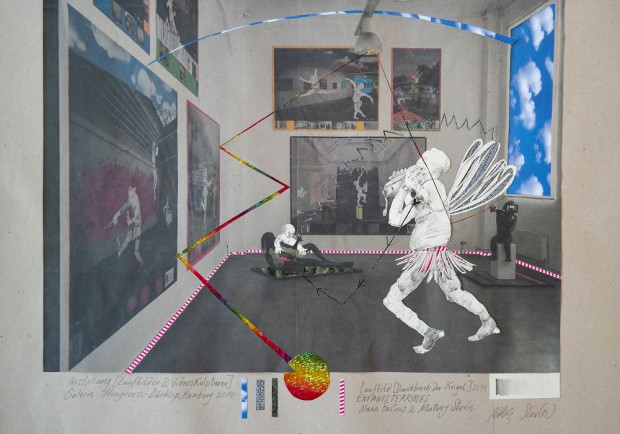„Enfants Terribles“ – Nana Bastrup & Matvey Slavin
Eröffnung: Dienstag, 21. Oktober, 2014, 18 – 21 Uhr
Es spricht Michael Stoeber (Journalist, Kunstkritiker und Autor, Hannover), 19 Uhr
Die Ausstellung findet im Rahmen des Interkulturellen Festivals eigenarten, statt [www.festival-eigenarten.de].
Dauer der Ausstellung bis 3. November 2014
Video mit Interview in der Galerie von Dr. Matthias Schatz März 2015.
Video über den Auftritt der Tänzerin und Choreographin Jessica Nupen (Johannisburg, SA) in der Galerie am Montag 10. November 2014, der noch im Rahmen von eigenarten, Interkulturelles Festival [www.festival-eigenarten.de] stattfand.
Das Künstlerpaar – Nana Bastrup (*1987 in Kopenhagen) und Matvey Slavin (*1987 in Sankt Petersburg) arbeitet seit ihrer Aktion im Jahre 2012 zusammen, als sie zu der großen Spinnenskulptur „Maman“ von Louise Bourgeois auf dem Außenplateau der Hamburger Kunsthalle 16 kleine Spinnenkinder dazugestellt haben. „Enfants Terribles“ nannten sie diese Aktion, ein Name, den sie beibehalten haben.
In ihrer gemeinsamen Produktion entwickelten sie eine eigenwillige Verbindung von Kunstdokumentation und Kunstwerk, die sie selbst in dadaistischer Manier als „Laufbilder“ bezeichnen: Bilder, die auch auf dem Boden liegen können und begehbar sind, Laufbilder, im chronologischen Sinne von fortlaufende Bilder, speziell aber auch Bilder ihrer eigenen künstlerischen Laufbahn. Vielschichtig ist auch die Methode der Herstellung: Inkjet-Drucke von Aufnahmen bisheriger Ausstellungen oder Aktionen auf Recyclingpapier, Collage-Eingriffe von Nana Bastrup, Bleistiftzeichnungen von Matvey Slavin vereint im Druck auf PVC-Plane, wobei auf einer Fuß- und Randleiste Farb- und Tonproben zu sehen sind. Das Ergebnis sind „digitale Gobelins“ [ca. 250 x 300 cm], die klassischen Wandteppichen nicht unähnlich, aber doch letztlich bedruckte Werbebanner mit Ösen sind.
Slavins fragile und skurrile Figurenwelt erweitert das rein Dokumentarische dieser Bilder um eine erzählerische Dimension, eine ins Fantastische verschobene Geschichte, die sich tatsächlich begeben hat. Bastrup schafft in den Raumsituationen und für die inszenierten Figuren von Slavin neue Zusammenhänge, durch Ein- und Ausschnitte, die sie freilegt und mit filigranen Linien und Farbreimen verknüpft.
Zu den Bildern gesellen sich überlebensgroße Plastiken. Der Besucher der Ausstellung erkennt zunächst unschwer die Zitate berühmter Werke wie den Denker von Rodin oder das Déjeuner sur l’Herbe von Manet, die durch ihr Material, Pappmaché über Holzgestell, das Ganze mit schwarzem Lack überzogen, ins Groteske verzerrt sind. Dann wird der Besucher zum Akteur, indem er über die Schulter der Figuren wie diese auf jeweils einen kleinen Bildschirm blickt. Im ersten Fall sieht er ein Kurzvideo, das Nana Bastrup eine brennende Zeitung lesend zeigt; im zweiten Fall sitzt die Künstlerin in einem Park vor einer Geräuschkulisse von Autos und schmeisst wild mit Lebensmitteln um sich.
Die Arbeiten sind auf produktive Weise provokativ, sowohl hinsichtlich gesellschaftsrelevanter Themen als auch hinsichtlich ihrer Haltung gegenüber dem Kunstmarkt, dem Kunstbetrieb und sich selbst.
Zur Ausstellung erscheint ein Katalog mit einem Text von Michael Stoeber.
Enfants Terribles—Motion Pictures and Video Sculptures
Nana Bastrup, Matvey Slavin
Opening reception: Tuesday, October 21, 2014, 6—9 pm
Introduction: Michael Stoeber (journalist, art critic, and author, Hannover), 7 pm
The exhibition is being held in the context of the Intercultural Festival eigenarten, Hamburg [www.festival-eigenarten.de].
The artist duo Nana Bastrup (b. 1987 in Copenhagen) and Matvey Slavin (b. 1987 in St. Petersburg) have been working together since their joint performance in 2012, when they placed sixteen baby spiders onto the outdoor plateau of the Galerie der Gegenwart in Hamburg next to Louise Bourgeois’s large-format spider sculpture Maman exhibited there at the time. They called their piece Enfants Terrible and have kept this name for their collaborations.
In their collective works, they have developed a unique interconnection between the documentation and creation of art, which they themselves define in the manner of the Dadaists as Laufbilder or ‘motion pictures’, which are intended for presentation on the floor and thus for being walked upon by visitors. The term Laufbilder also denotes that the works are continuous in a chronological sense as well as being specific representations of their own progressing career as artists. The method for producing these works is equally complex: inkjet prints of photographs of previous exhibitions or performances on recycling paper, collage interventions carried out by Nana Bastrup, and pencil drawings added by Matvey Slavin are united in prints on PVC tarp, leaving color test patterns visible on the bottom and side margins. This procedure results in the rendition of “digital Gobelins” [dimensions: c. 250 x 300 cm], which recall classic tapestries, but in reality are printed advertising banners with loops.
Slavin’s fragile and scurrilous arsenal of figurations goes beyond a purely documentary approach, lending the works a narrative dimension—a story which is transposed into the realm of the fantastic, but which has actually taken place. By cutting into, extracting, and exposing elements, which she combines with delicate lines and color rhythms, Bastrup creates new contexts for the figures staged by Slavin in the spatial situations.
The pictorial works are complimented with sculptural objects, which are larger than life size. At first glance, the viewer of the exhibition easily recognizes the quotes referring to famous works, such as Rodin’s The Thinker or Manet’s Déjeuner sur l’Herbe, which, however, through the material of which they consist – papier-mâchéupon a wooden frame, covered by black enamel paint – are distorted into the grotesque. At this point the visitor becomes an active part of the works by looking over the figures’ shoulder and, in imitation of these, focusing upon a small monitor. In the first case, a short video is to be seen depicting Nana Bastrup reading a newspaper that is on fire; in the second case, Bastrup is sitting in a park surrounded by the noise of traffic, frenetically flinging food into the landscape.
The works are provocative in a productive manner, both with regard to addressing socially relevant issues and to critically reflecting the art market, the art scene, and the role the artists adopt in these.
A catalogue will be published in conjunction with the exhibition, with an essay by Michael Stoeber.

